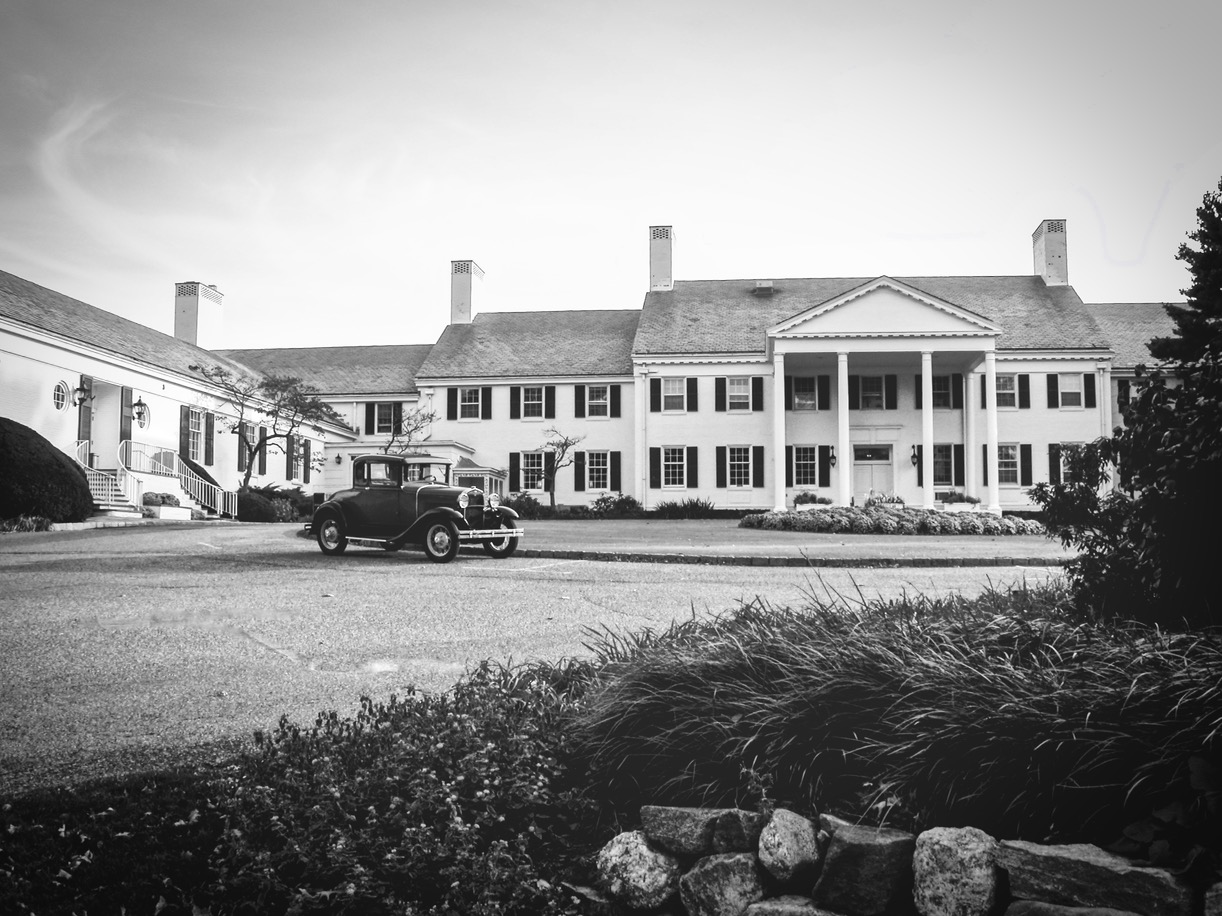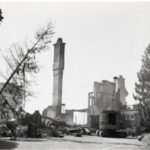Originally written by Carl White.
According to the book, the club was started by Julian Curtiss, a Yale graduate who eventually became President of the sports equipment giant Spaulding. He became interested in golf, and in 1894 was responsible for his company manufacturing the first set of golf clubs in America. Julian, his brother, and a sports enthusiast neighbor combined some of their property to form a small, five-hole golf course. The course had 9 holes by 1895, and by 1908, the course was expanded to 18 holes. This eventually became the Fairfield County Golf Club – the predecessor of Greenwich Country Club. Curtiss invited friends out to a barn in the meadow, which is now part of the GCC. It’s said that Curtiss had to bribe them with an oyster supper! But once the men got a taste of the game (and oysters), the sport became very popular.
In 1892, Warren Smith purchased a 102-acre plot of land on North Street, previously known as the Hanford Lockwood Farm. An adjacent property owner joined with Smith to create a residential park on speculation. The sale of land lagged, so Smith donated some of the lands to the Fairfield County Country Club. It was located in the area known as “Electric Hill.” This was because Edward H. Johnson, president of the gas and electric company that would become CONED, lived in a house in the area that Thomas Edison claimed was the first electrified house in the world. The Fairfield County Country Club was officially opened on September 7, 1895.
Membership expanded to 200 people by 1896. This included NYC bankers and brokers, Irish and Scottish immigrants, Civil War veterans, and a prominent builder. Families paid $40 for a family membership, men paid $30, women paid $15 and non-residents paid $20. In 1897, charter memberships were offered for $100. The Club held many prestigious tournaments which also contributed to its financial well-being.
Edmund Converse, a Boston native and successful businessman, moved to Greenwich in 1902. He was President of United Steel and served on several corporate (financial) boards. Converse built the 1,300 Conyers Manor. He also became a benefactor and leader of the Fairfield County Golf Course as a 3-term President. His generosity made it possible for the club to expand to 18 holes. By 1909, the name of the country club was changed to the Greenwich Country Club.

A second fire occurred on January 11, 1929. Although trucks from the Amogerone and Volunteer Fire Company, Cos Cob Fire Department, Glenville Fire Station, and Sound Beach Volunteer Fire Company responded, firefighters had to deal with a scarcity of water to fight the fire. There were no nearby fire hydrants. Water had to be drawn from the Brothers Brook, and the fire probably lasted longer than it should have (5 hours). Fortunately, there were no fatalities. One fireman had to be treated for smoke inhalation. Estimates placed the losses at $150,000 while the loss of furnishings was placed at $25,000. Insurance only covered about $75,000 – half the loss. A local architect – William F. Dominick (who designed several Greenwich projects including Riverside School and Christ Church) was commissioned to rebuild the clubhouse. Many improvements were made, especially an increase in the number of bedrooms from 30 to 52. The first fire that impacted the club – at that time known as the Fairfield County Country Club – occurred in January 1896. Warren Smith was leasing his villa at the corner of North Street and Fairfield Road as the clubhouse. Smith’s home on Old Church Road burned to the ground, and Smith moved to the villa, forcing the club to move. However, Smith built a new Colonial-style clubhouse, known as “The Gazebo.” It had a magnificent view of Long Island Sound – including Oyster Bay.
The third and most damaging fire broke out at 2 am on Labor Day, September 5, 1960. Since the fire started smoldering in the walls and progressed slowly, it was difficult to find and fight it. Its cause was believed to be electrical in origin. At 4 am, a large explosion spread the fire, and the south side of the ground floor was enveloped in flames. A section of the south wall on the north wing collapsed, and a roof over two wings crashed down. Forty-two residents were led to safety.
Sparks and dark plumes of black smoke rose in the sky. It could be seen as far away as Stamford. Approximately 100 firefighters fought the fire for 14 hours. Water was pumped from the club’s pool and a lake on the club property. There were no fatalities, but 4 firemen were taken to the hospital and 15 firemen were treated for smoke inhalation. Valuable paintings were lost – including portraits of previous club presidents. Several club trophies were destroyed such as the Queen Victoria Diamond Jubilee Cup. Since several guests lost clothes in the fire, Richard’s and Peck and Peck clothing stores opened on Labor Day so people could buy new clothing. The building was burned to the ground, and only some chimneys and cement work remained.

As club members contemplated rebuilding, a controversy arose. Some members suggested moving to Backcountry. After some review, it was determined that there was no suitable land available for a new country club. Prices were too high. The members voted to stay in the current location. Some members took exception and left to found the Stanwich Club.
In May 1961, a meeting was held in the Brunswick School auditorium. Members voted to build a 3-story Georgian Colonial, built from cement blocks with a white brick veneer. The new building would be similar to the old one, with the exception of a private dining room and ballroom in a separate wing. Nineteen bedrooms and suites were to be built on the top floor.
Until the new building was complete, the squash house was used as a clubhouse office, while the doubles court became a dining room. A bright striped tent attached to the squash house was used for dining, dancing, and parties. On Sunday, a buffet lunch was served from 12 noon until 4 pm.
The new clubhouse was opened in December 1961. It hosted a Debutante Cotillion on December 22, and a Governor’s reception on New Year’s Day. A golf architect was hired in 1962 to make minor changes in 1963, and several major changes were made in 1964. Since then, some minor changes have been made, but the emphasis has been on maintaining the buildings and grounds.
As you drive through Town, you may catch a glimpse of this unique structure on “Electric Hill.” It’s been the site of many important tournaments and events. Despite the fires and some challenging times, it’s amazing how the Club has continued to carry on as normal, without any interruptions. Hopefully, there won’t be any more fires to disrupt its operation.
SOURCES
MacEachern, F; Greenwich Country Club Fire 50 Years Ago Remains a Vivid Memory; Greenwich Time, September 7, 2010.
Quirin, WL et al; The Greenwich Country Club 1892 – 1992; The Donning Company, VA; 1993.
ABOUT
Build your family tree, dive into the history of your historic home, and discover photos and articles of days gone past with the Library’s collection of 5,000 books, 800 Oral History transcripts, yearbooks, historical maps, vertical files, pamphlets, periodicals, and microfilm and microfiche. Plus, access resources like American Ancestors, AncestryLibrary, and more with a Library card. Learn more at greenwichlibrary.org/genealogy.
Get the latest about the Library’s History & Genealogy events and offerings sent to your email: greenwichlibrary.org/enews.
Questions? Contact:
Local History Librarian
(203) 622-7948
